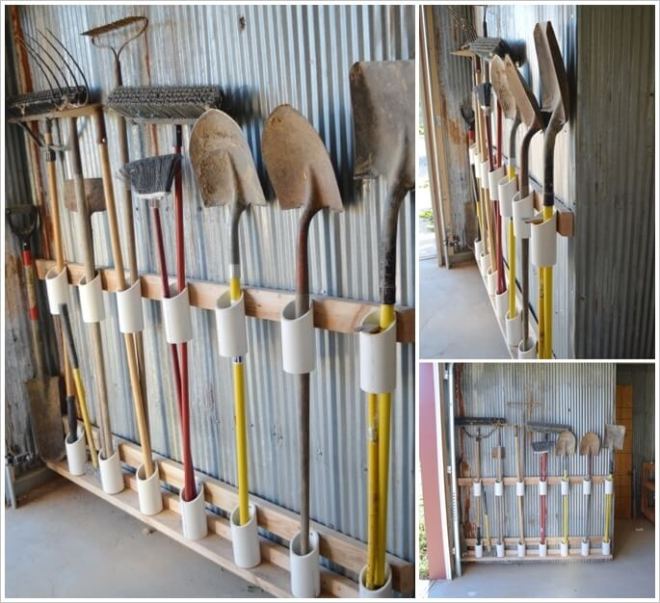Garden cabinet - for tools and more
This idea haunts me for a long time. I really want to have a small locker for those tools that are constantly in use - so as not to stomp every time for your favorite shovel in the barn, and for the pruner into the house. Moreover, the structure of such a structure is extremely simple, it is easy to build, and it does not take much space. You can even rearrange the miniature storage if necessary - it's no more difficult than moving the closet in the house.
A garden cabinet can be quite small
Although, if desired, the cabinet can be made wider, more spacious and more massive, and on the door you can attach practical containers for all sorts of little things or a folding table on which it is convenient, for example, to leave a box of seeds or your garden diary to keep the necessary notes immediately during work ...

A garden cabinet does not have to be a free-standing structure - you can attach it to the wall of a house or utility room. Good materials and thoughtful design will make this household object not only comfortable, but also stylish.
A garden cabinet can be not only comfortable, but also stylish.
The internal space of the storage can also be organized according to your taste: make shelves, hang hooks, equip stands if there are a lot of tools in it (for a couple of shovels, I think you can use stands and not bother). Such a structure will not replace a full-fledged barn, of course, it has a different role: it is a place where something that is constantly in use and should always be at hand is conveniently stored.
Planting cone for bulbs
270 rubRussian Garden
Secateurs Classic
269 rubRussian Garden
Planting scoop narrow with wooden handle
59 rubRussian Garden
Garden rake with telescopic handle 170 cm.
500 RUBRussian Vegetable Garden
Sealed containers for storing substances
The dacha stores not only tools and equipment, but also building mixtures, varnishes, paints, materials and reagents. Add fertilizers, sprayers, insecticides and other formulations to them. Breathing the "aroma" of many of these substances is undesirable and sometimes harmful to humans. Therefore, they must be stored in sealed containers, preferably tightly sealed containers. Here the "golden rule" applies: "The more toxic the drug, the higher it should stand on the rack." And of course, do not forget to always carefully study the storage conditions indicated on the labels of building mixtures, garden preparations and other substances. Some of them do not tolerate freezing temperatures, others - excessive air humidity. All kinds of mixtures should be kept in their original packaging or in reliable and sealed containers. However, tools and parts are also best kept in special suitcases or organizers.
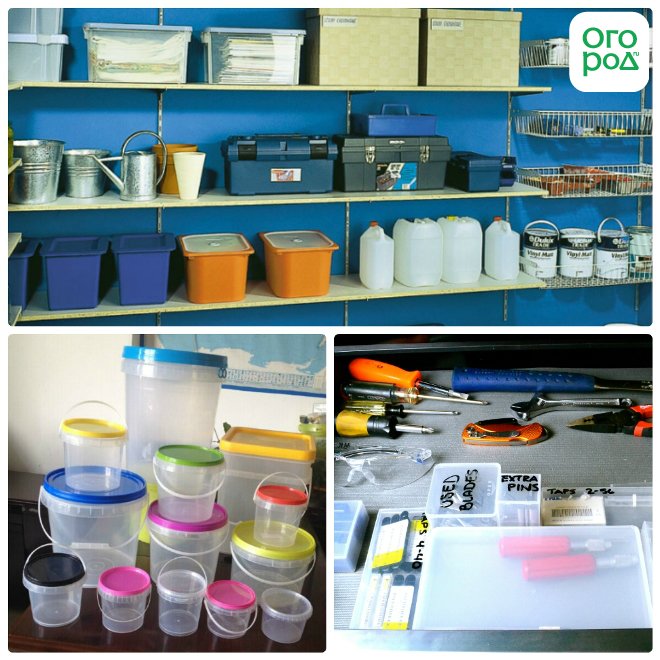

As you can see, there are quite a few options for storing garden tools. It is worth showing a little imagination, and instead of a chaotic warehouse of old things, you get a beautiful and well-groomed space in which everything is laid out in its place.
With the onset of warmth, gardeners and gardeners get tools and various household equipment from sheds and closets. In the midst of spring work, everything that a summer resident needs should be at his fingertips. There is a constant need for shovels, rakes, shovels, forks and pruners. On the one hand, they need to be as close to the work site as possible. On the other hand, how do you not want the neat view of the site to be disturbed by the objects scattered around! There is only one way out: you need to define and equip a place for the summer storage of tools. And in winter, they also have to be put somewhere in order to fully meet the new summer season.
10 general rules for preparing for winter storage

But at the same time there is a few general rules for preparing for conservation:
All tools must be cleaned of soil, dirt, grass and other things, washed and dried thoroughly.
... The key point at this stage is to "dry", as sometimes patience is not enough for this. The moisture remaining in the cracks and joints of parts, once it gets into an unheated room (for example, a shed), will turn into ice in the cold, which can seriously damage inventory. Not to mention the technique. To avoid this, leave the tools for a couple of hours in the sun or keep in a warm room until completely dry.
Important:
in order not to puzzle over how and what is better to wash, shovels, scoops, and remember the universal method. The tools are poured with water up to the handle for 30 minutes.
If desired, washed with a washcloth or sponge. If the dirt just "does not give up" then it is worth adding laundry soap, dishwashing detergents or other to the water.
All tools and equipment should be inspected for wear.
or damage to parts. Determine for yourself what needs to be replaced first and what to take note of. Winter is a great time to repair your inventory!
Accessories requiring lubrication must be lubricated accordingly.
For example, cutting edges to prevent rust.
The owners of plastic tools need to carefully study the instructions, paying special attention to temperature criteria. Not all plastic is frost resistant!
Sharp tools (garden shears, etc.) or tools with teeth (hacksaws, etc.) are best stored in a case, after being sharpened
If there are no special covers, you can adapt what you have. The simplest option is thick cardboard or plastic boxes, old for watering, cut lengthwise (like a skate cover) and put on sharp teeth. Some craftsmen make covers even from the sleeves of old jackets. This method works well for a saw.
Wood handles and handles of tools are also cleaned, washed thoroughly and dried even more thoroughly. You can cover them with a fresh layer (without forgetting, of course, to clean off the old one).
It is very important to store the instruments upright
or on special wall hooks. So they will not get wet from the floor once again.
For fire safety purposes, gasoline from equipment must be drained
.
The oil from the garden equipment cannot be drained, it must be replaced with a winter one, with a different viscosity (if there is a possibility that the equipment will occasionally be started in winter) or with a special mixture for conservation (if the equipment will definitely not be used).
Premises
for storing equipment and tools, it must be dry, well-ventilated, fireproof and with a secure lock.
Metal panels for storing tools (pegboard)
Metal sheets with fine perforations are a real find for lovers of strict style from the category “to have everything at hand”. The result is a double economy - both the tool is in sight, and the workbench or work table is always free. And there are benefits to this “wall perfectionism” for forgetful or very generous hosts. When the entire tool is in place, you can immediately see what is missing, and you can either bring the forgotten tool from the garden, or remind your neighbor to return the borrowed drill. The metal shields are equipped with numerous holes into which fasteners for different tools can be inserted. This system is suitable for both small and large rooms.

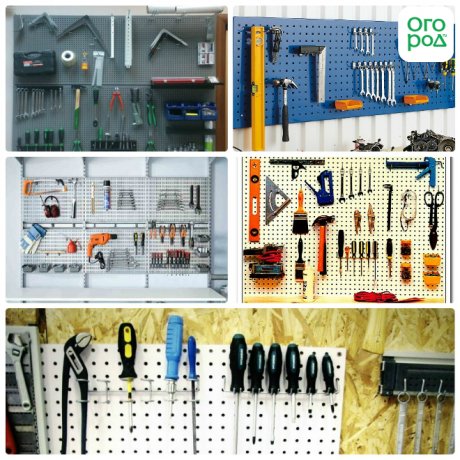
Construction of a utility block - the optimal area
On the one hand, such a structure does not take up much space on the site, on the other hand, does it exert any load of 0.2% on the remaining 99.8%, even if the area of the site is small - 6 acres? The obvious answer is no.
Possibilities - the design serves only for its intended purpose or for other purposes (work in the workshop, taking a shower and toilet).

Availability of transport (the larger the vehicle, the more parts and consumables it has).
As a result, there is no specific area of the utility block that will suit everyone. After all, someone wants to dine near the machine, while someone loves the space inside any room.
Obviously, the area of the utility room should not exceed the area of the combined living room and bathroom.
Optimal storage conditions
When storing a beekeeping product, it is necessary to create the necessary conditions in order to minimize losses associated with spoilage and loss of useful qualities.
It is important to protect pollen from contamination by bacteria and fungus.
To preserve the healing properties, the raw material is placed in a glass container with a tight lid. The container is pre-sterilized and dried. Keep the filled container away from sunlight, high temperatures and high humidity. You can store pollen at room temperature or in the refrigerator. The loose substance does not lend itself to freezing, since at sub-zero temperatures it loses its beneficial properties.

After drying and sifting, the prepared shredding can be stored for up to two years. The term depends on the storage conditions. Even if all conditions are met, a natural product loses 40% of its usefulness within a year. Therefore, for two years towards the end of the shelf life, only the protein compound is of value. There are practically no vitamins and minerals in the composition.
DIY shelf!
Take a board, the length of which is from a meter, and the thickness is at least 4 cm; you will also need some remnants of boards and all kinds of planks, plywood trimmings in the shape of a triangle, of the same size.

In each triangle, make grooves the same size as the largest board. Connect the triangles to the strips using self-tapping screws. The edges need to be cut. And as a result, you get each of the triangles, a console.

Further, all consoles separately should be attached to a large board using self-tapping screws. In the process, make sure that the inventory can be hung up with the working part. In between consoles, insert boards
This is important for stiffening.

As a result of the work done, you will have a fairly heavy shelf, which cannot be attached to the surface of the room wall without an assistant.

In fact, there are a lot of options for how to store tools in the country. And no one forbids you to fantasize and create your own, your own developments. A very interesting option for storing inventory is the organization of a garden organizer.

KONICA MINOLTA DIGITAL CAMERA
And so that you do not have to run for new garden tools at the beginning of each season, be vigilant and observe the correct storage conditions for your tools. Think carefully about the storage system so that they are reliably protected not only during the season, but also during frosts.

Original wall mounts
Here is perhaps the fastest and simplest idea: we take an old garden hose and attach it to the wall so that the cuttings of garden tools can be inserted into the formed "loops". Everything! I would, perhaps, slightly improve the idea by laying the hose not in one, but in two rows, one under the other - so our inventory will be more stable.

The old hose will still serve: an inventory holder that can be made in a few minutes It will take a little longer to make fasteners from pipe scraps. Well, the idea with construction buckets seemed to me worthy of attention. Although in this case, the durability of the structure is in doubt: with constant use, the upper buckets are likely to quickly deteriorate.
It's all about: tool holders for pipe cuttings and construction buckets
But here, after all, the main thing is the idea, and then you can creatively develop it: for example, take buckets not plastic, but old galvanized ones - they are much stronger ...
Garden organizer made easy
For a simple garden organizer, we do not need extra efforts and significant financial costs. It's pretty simple!
We need four 25mm thick edged boards. They need to be prepared for work - trimmed. The picture shows where the holes will be placed on the two planks. Let's outline them. With the help of a feather drill, we will make holes according to the preliminary outline and, then, with a jigsaw or a simple hacksaw, we will cut out the side cuts.
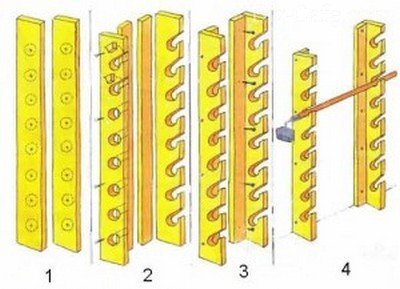
There is nothing complicated in assembling such an organizer. The whole simple process is reflected in sufficient detail in these figures.
We connect the boards in pairs with self-tapping screws to get two L-shaped structures. We now have two vertical posts. We select the wall on which our organizer will be placed. Let it be, for example, the outer wall of any outbuilding. The racks must be screwed to it parallel to each other at a shorter distance than the length of the shovel handle.
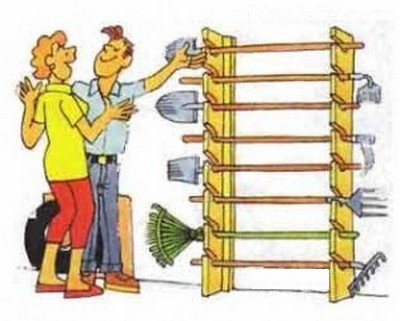
Why not boast of such a decent work result? It is always pleasant to keep the instruments in order. It will be more fun to work with a clean inventory.
The work is over. It remains only to put all the inventory in the organizer and be glad that it will always be in order.
We make a shelf with our own hands
There are a lot of ways to make a simple tool shelf with your own hands. We bring one of them to your attention. For the base of the shelf, we need one board over 1 meter long and 40 mm thick. In addition, we will prepare the remains of boards, planks, as well as identical triangular-shaped plywood trimmings.
We take plywood triangles and on each of them we cut out a groove with a jigsaw corresponding to the board that we have prepared for the base of the shelf. With self-tapping screws we fasten the trims of the planks to the triangles, we cut off their edges. Now each triangle is a console.

This shelf is easy to make: there is no point in buying new materials to create it, you can use those left over from previous construction work
Using self-tapping screws, we fix each console on the base board so that shovels, rakes and other tools could be suspended with the working part up. Cutting boards or chipboard should be inserted between the consoles. This will give the overall structure the necessary rigidity.
I must say that the finished structure turns out to be quite heavy. To fix such a shelf to the wall, you need an assistant who will support it. If the master works alone, then it is easier for him to initially fix the support board, and only then screw the consoles and elements that provide rigidity to it.

The only difficulty is the weight of the shelf itself, which will be a problem if you have to fix it to the wall alone, but in this case there is a way out
Another option involves fixing the finished structure with one large nail, and then the final installation with self-tapping screws. Through holes can be made in advance in their locations. The resulting simple shelf collects all the basic inventory.
Storing garden tools and other things in the country
As a rule, a country house, the area around it and all outbuildings resemble a warehouse for temporary storage of various tools, garden and sports accessories, and seasonal items. In this case, the main task facing the owners is to organize the space on the site in such a way that the atmosphere on it becomes functional, and the work brings only pleasure, without wasting time and effort.
You should not litter the country house and outbuildings with broken things, because, more often than not, there is not enough time to repair them. Therefore, it will be more expedient if the necessary tools take the place of the broken things. First of all, you should get rid of rusty equipment, broken boxes, old paint cans and expired fertilizers and various chemicals, old, worn gloves and broken equipment.This will help free up additional space for convenient storage of things and garden tools in the country.
Storing garden tools: ideas
Throughout the year, the summer cottage must be looked after: loosen and level the soil, transplant flowers, harvest, remove fallen leaves. Therefore, garden tools must always be kept in good condition.
Special attention should be paid to the storage of garden tools. Each piece of garden tools must occupy a specially designated place for it.
For example, for storing equipment, you can build a wall-mounted container out of boards, in which you can make several compartments of suitable width and depth so that the sharp parts of the tools take a safe position.
Rakes, shovels and forks can be stored on the wall of a garage or shed by attaching special hook holders to it.
For garden tools that are stored outdoors, it is necessary to make a container with a canopy. This will prevent moisture from entering the tools and the formation of rust on the metal parts of the equipment.
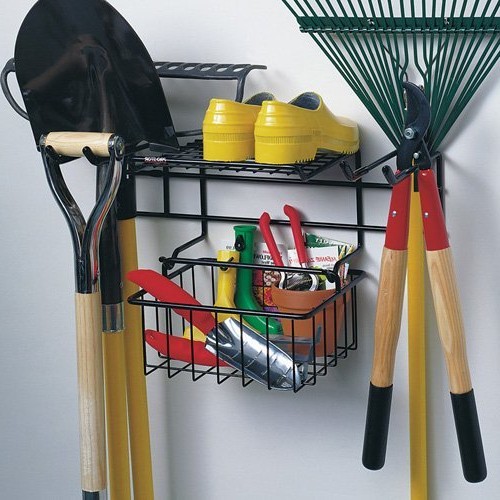



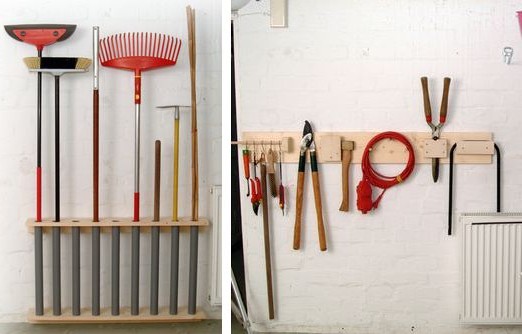
When the summer season is over
When the cold comes and the work in the country ends, it is time to preserve the tools that served us faithfully and send it for storage. If you follow all the rules, in the spring we will not have to spend money on buying a new one. Spring costs are already high.
All shovels, hoes, rakes and other gardener tools should be preserved. We will carry out their initial inspection and repair everything that has broken down during the working season. Dirt and rust must be removed. Cleaning is best done with a wire brush or putty knife. Lubricate the cutting edge and metal surfaces with oil.

Do not leave tools dirty and unlubricated for the winter. All the same, the very same spring will have to do the same work. And in the spring, as you yourself know, there are a lot of things to do without it
It is necessary to sharpen the blades of the delimber and secateurs. Use a file to remove any jagged edges from a delimber or garden saw. A sharpening stone is better suited to the pruner for the same purpose. You also need to take care of the wooden handles. They are also thoroughly cleaned, after which they are abundantly lubricated with ordinary sunflower or linseed oil. Soaked in this way, the handles will not dry out and will last a long time.
Particular attention should be paid to the fertilizer sprayer. It is cleaned, washed thoroughly and dried.
All levers and fixtures of the device are thoroughly coated with machine oil. Free the hoses from residual water, roll up into a ring and hang on the wall. Store them only indoors.
A well-equipped suburban area cannot do without electromechanical equipment. When preparing it for winter, the following steps are necessary:
- draining all excess fuel;
- replacement of engine oil;
- checking the presence of fasteners (brackets, plugs, screws) and filling the actual shortage.
Power cords also require mandatory inspection. If the integrity is violated, it is better to replace them with new ones. The trimmer head is cleaned, washed and dried. Mower knives are sharpened and lubricated. Both electric scissors and a grass shredder need cleaning. All knives, metal parts and movable joints of various units must be cleaned and lubricated.

Any electromechanical device needs careful maintenance. But the life of a gardener and a gardener is greatly facilitated if he has them and are in good condition.
The tool should never be left where it can be wetted by rain or covered with snow. Even moisture from fog negatively affects its performance. A special utility room would be an ideal storage place. If there is no such room, a workshop or even a storage room in the house will do.Thoroughly preserved gardening tools will successfully survive the period of lack of demand and will not let their owners down in the spring.
Storing garden tools vertically
The device for vertical placement of garden tools looks somewhat simpler. You can also use a wall. 
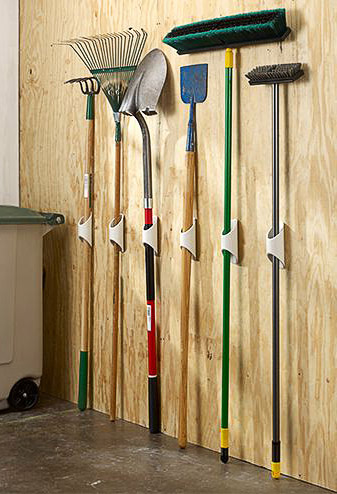



There are many mounting options. From simple hanging to using tubes. The pros and cons are the same as on the Swedish wall above. Everything in sight, good access, but takes up a lot of wall space.
More economical in terms of the occupied area looks like the option of storing garden tools in a special device, reminiscent of a box, divided from the inside into departments.
The design is possible in different ways, it can be clearly seen in the photos below. 

The disadvantage of this design is the difficult access to the tools in the center. You will have to pull out from many neighboring ones, which may not always be convenient and fraught with injuries.
Storage of small garden tools
So far, it has been about organizing the storage of large garden tools, such as shovels, pitchforks, rakes, etc.
But there are also small shovels, secateurs and other "trifles". You can make small shelves, holders for them (photo below).

For longer storage, it is recommended to use a container filled with sand with a small addition of vegetable oil. It is better not to use machine oil, because there is a risk of bringing it into the soil, and we do not need it. Better to use flaxseed oil. 
Just stick the tool in the sand and that's it. Of course, the storage must be dry, otherwise your tools will rust.
As for the storage of the watering hoses, it is not advisable to store them suspended on thin holders.
Under their own weight, they can sag and get a kink at the place of hanging. An interesting option is in the photo below. 
Screw an old bucket or saucepan upside down to the wall. Original and convenient. And the internal volume of the bucket can be used as a shelf for small things.
However, the hoses can be stored rolled up and lying down.
You can read how to prepare your garden tools for winter storage.
Usually, garden equipment is simply stored in a barn or basement. It is difficult to achieve order with this method of storage, and it is not easy to find the right thing quickly. Isn't it time to clean up your property? Here are some valuable ideas.
Often, a country shed or basement is a real secret room, the contents of which are almost unknown even to its owner. What is missing here: garden tools, appliances, old furniture, a set of summer or winter tires, spare parts for a car, building materials, power tools, etc. To find something, you need to carry out real excavations. Therefore, to help summer residents, special techniques were invented and systems for storing inventory were developed.
Storage extension methods
Conservation will help preserve the usefulness, extend the shelf life of the bee product. The pollen is mixed with honey in a 1: 1 ratio. The apiproduct is stored in a cool, dark place, away from sunlight and moisture. The pollen is preliminarily crushed with a coffee grinder or blender, then mixed with honey. The shelf life in this case reaches up to 5 years.
The pollen mixed with honey makes the product taste better. In combination, two useful components only enhance their healing properties. The mixture becomes richer in the amount of vitamins and nutrients.
Pollen is a storehouse of medicinal properties for human health. In the absence of allergies, it is recommended not only for the treatment of a number of diseases, but also for the prevention of ailments.
Share link:
Garden toilet ... for tools
If there is not much space on your site, and a large shed will take out a considerable part of the fertile land from circulation, you can build or purchase a small, "individual" room for inventory. An ordinary country toilet is quite suitable for this role.Considering that most of the garden tools are long rakes, shovels, hoes, hoes, etc., it is best to store them not in a long, but in a high room. This booth can be slightly modified and, depending on the number of tools available, a few hooks can be nailed to the door, shelves can be hung, or a vertical stand can be installed. A small pantry can be adapted for the same purposes.




Where to store equipment and equipment
Option 1. In the barn
- Large items (most often gardening equipment) are placed on the floor, preferably at the entrance - in case something is urgently needed in winter (for example).
- Small inventory, as noted above, is stored suspended on hooks or in containers (can be in) attached to the wall. The order of the arrangement depends on the frequency of use. A chopper is unlikely to be needed in winter, but a shovel is quite. Even if there is a special shovel for cleaning, an extra one can always come in handy.

Option 2. In the garage

The inventory stored in the garage must not harm the vehicle. That's why do not place it close
to the parking place of the iron horse (minimum distance - 1 meter). Hanging too high and close is also not worth it. Imagine for a second your favorite car and a pitchfork or a rake flying at it ... An unpleasant picture! Anything can happen, sometimes even the most reliable fasteners and hooks fall off, so it's better to play it safe.
Option 3. Put into special storage

Interesting:
such warehouses are not very common in Russia. In Europe, on the contrary, the self-storage service is very popular, because Europeans value every free square meter and will not tolerate, even temporarily, unnecessary boxes, containers and other things in a house or apartment.
In case you decide to try temporary storage, please note:
- on the reputation of the company,
- how long she has been storing things,
- as well as what types of storage it provides.
Construction of a utility block - categories
When the place is chosen and the area is known, then it remains to decide on the category of the utility room. It happens:
- Typical;
- Capital;
- Mobile.
As it was written in the previous section, the capital structure is a utility unit with a toilet and shower, while the typical model is simply designed to collect inventory, supplies and crops inside itself.
The difference between the two makes the difference between their performance. From here it becomes clear that the capital utility room is not limited to walls, floor and roof alone. But there is also a mobile option that stands out:
- Finished construction;
- The presence of a wheeled chassis and a trailer.
The corresponding utility room is rightly called a change house if conditions for living are created inside it.
But then little space is allocated to the room for tools and supplies. Therefore, which utility block is better - stationary or mobile - is up to the target audience only.





































